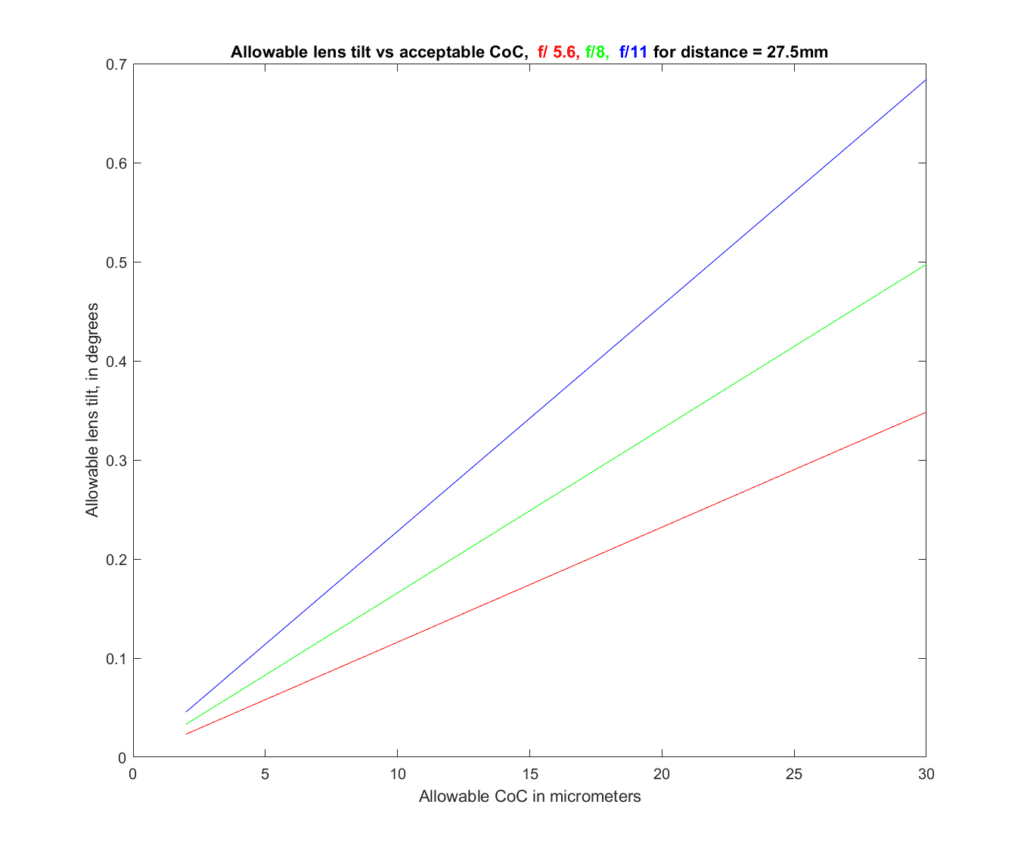Lensrentals has loaned me a Fuji GF 30mm f/5.6 tilt/shift lens. There have been reports of unwanted tilt when using this lens. I conducted an analysis of how much tilt it takes to cause various amounts of defocus error. While the stimulus for this work was the 30/5.6 T/S lens, it is applicable to any lens.
My metric for defocus error is the circle of confusion (CoC). If the focus plane is displaced from the sensor by x, and the effective f-stop is f, the diameter of the circle of confusion is:
CoC = x/f
or, stated another way:
x = CoC * f
Assume that the image is in focus at one point p1 on the sensor, and we wish to find the CoC at a point p2 on the sensor a distance s away, with the tilt direction orthogonal to the line between p1 and p2. We must first calculate x:
x = s tan(theta), where theta is the angle of tilt away from that desired (in the case where no tilt is desired, the lens axis should be perpendicular to the sensor plane).
for small tilt angles, x = s * theta, with theta measured in radians.
Putting those two equations together:
CoC * f = s * theta
So theta = CoC * f /s
If we want theta in degrees, then theta = 57 * CoC * f /s
Now let’s get specific to the GFX sensor. If we focus in the center of the image and measure the focus error at the corner, s = 27.5mm.
Here’s a plot of the results for various CoCs and three f-stops:
The pitch of the GFX 100x cameras is about 4 micrometers (um). For critical work, the amount of defocus error allowable is that which causes a CoC of 2 or 4 um. If we use 4 um, At f/5.6 we can tolerate less than 0.05 degrees of tilt.
One conclusion from all this is that the 30/5.6 T/S lens is not a complete replacement for the GF 30 non-shift, non-tilt lens. With the latter once you’ve verified that the lens is correctly constructed, you don’t have to worry about the lens having tilt that you don’t want. Not so with the 30mm T/S lens; you won’t be able to accurately set the tilt to zero, even using the lock function. The tolerances are too loose for that. And that ignores the substantial size, weight, and complexity penalties of the T/S lens.
T/S lenses are great for their intended purpose, but they are not panceas.

Samuel Chia says
Fascinating, thanks Jim! I used a different method and worked out the amount in microns of lens extension at the sensor’s edge, and it was just under 45. For those who find it hard to visualise such tiny errors, essentially it means that if you took a sheet of regular letter sized office paper, somehow manage to cut its thickness in half, and stuff that between the GFX and lens’ bayonets when you are mating them together, assuming no compression of the half-thickness paper, you are introducing, more or less, about the same amount of error Jim describes above.
CarVac says
Interesting. A 0.05 degree tilt on the corner of a GFX sensor with an ideal 30mm lens moves the focal plane from 2 m to 1.90 m, or from infinity to 37 m.
I find the inclusion of tilt in wide lenses to be fairly perplexing, because of the insane sensitivity when you want to align things properly. Conversely, I find the inclusion of shift in longer focal length tilt-shifts to be of rather limited use unless you’re stitching.
(Note: my personal experience is limited to longer lenses, Hasselblad 50, 80, 180 with a tilt-shift adapter)
Also, this makes the precision required for proper focus of large format cameras seem rather difficult to obtain.